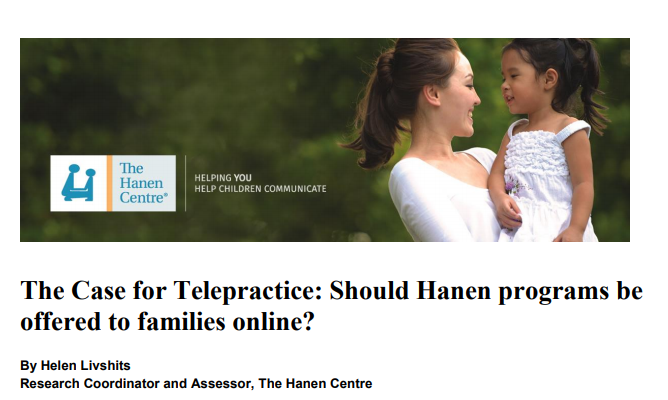
As an occupational therapist who is considering offering teletherapy services, it is vital to gain buy-in from stakeholders, such as referral partners and parents, in order to build a sustainable and successful telepractice.
The Biggest Obstacle Facing Teletherapy
One of the biggest obstacles that teletherapy is facing is that some people are not yet taking it seriously. While it has been found that teletherapy is just as effective, if not more effective, as traditional methods, not everyone realizes this. Part of the responsibility of an OT who is offering teletherapy is to communicate with stakeholders so they clearly understand the benefits and why it is such an important component to add to their current model.
Identify Your Stakeholders
When looking to build support for your teletherapy practice, it is important to identify who your stakeholders are.
How Do You Know Who to Target?
Stakeholders can vary and will depend largely on your specific practice, but they can include students and parents, professional associations, third-party payors, state and federal legislators, teachers, school administrators, staff and/or colleagues, medical facilities, and medical support staff.
Before you can begin communicating to your stakeholders to help them understand the importance and benefits of teletherapy, you have to identify who the key players are and how you will begin making contact with them. A helpful question to ask yourself in order to begin this process is:
“Who can help you build and promote your program and who will benefit from it?”
How to Enlist Support
Enlisting support from stakeholders can make or break your teletherapy practice. There are several components you will want to focus on when beginning this process.
Is Teletherapy Effective? Know the Evidence
First, it is incredibly important to make sure you are communicating to your stakeholders that teletherapy is as effective, if not more, as traditional methods. Be sure to use statistics and data when presenting this concept and have research to back up any claims you make.

For example, a study that was conducted by Hedda Maedan, associate professor in special education at the University of Illinois, and colleagues found that teletherapy does not have any negative impact on clinical outcomes versus in-person treatment. The study reports that as long as live face-to-face instruction, review of teaching materials, implementation of strategies, and ongoing feedback are consistently occurring, then teletherapy provides similarly positive outcomes.
Teletherapy has been found to be exceptionally effective for children since they are particularly motivated by the use of technology and sometimes find it even more engaging than working with an OT in-person.
Another study conducted by Crutchley and Campbell in 2010 found that the majority of parents and teachers who participated were satisfied with teletherapy and that they were optimistic about its future.
While the study was for speech-language pathology instead of occupational therapy, a study that involved a speech pathology program delivered through teletherapy to a school-aged population, it was found that there was buy-in from all stakeholders. They determined that the program was feasible and acceptable to the school principals, therapy facilitators, and parents alike. The study also found that the best way to encourage stakeholder buy-in was through careful planning processes and effective communication.
When stakeholders realize that teletherapy produces the same results as in-person treatment and are provided with the research to back up this claim, they will be much more likely to understand the need for this model of service resulting in stakeholder buy-in.
What’s In It for Them?
Creating stakeholder buy-in will rely heavily on getting each stakeholder to understand how teletherapy will benefit them. While the benefits will differ depending on who the specific stakeholder is, some significant benefits of teletherapy are mentioned here for reference.
Save Time and Money
Teletherapy is a cost-effective solution that allows individuals, parents and caretakers, and OTs to reduce travel expenses and save time due to the convenience of virtual care. Organizations are also able to save on costs such as physical space and materials used during in-person treatment (this includes flip charts, hard copies of resources, projectors, name tags, beverages, etc.).
Improved Access
The use of teletherapy allows underserved populations to receive effective treatment and care. This can include individuals in rural areas and those with disabilities who are unable to travel. Essentially anyone with a stable internet connection is able to access teletherapy services.
Flexibility
Since teletherapy does not need to be provided in a traditional clinic setting, this gives more flexibility to operate outside of typical business hours making this a much more viable option for families and those with busy schedules. This also makes the rescheduling process simpler and no-shows are less likely to happen.
Parent/Caretaker Involvement
For parents and caretakers specifically, teletherapy allows them to be much more involved in their child’s progress since they can help facilitate the sessions in their own home.
Improved Efficiency
Overall, teletherapy is an incredibly efficient model that saves time, money and other resources while being accessible and convenient for all parties involved.
Helpful Tips to Encourage Buy-In
Getting stakeholder buy-in for teletherapy doesn’t have to cause headaches. There are many ways to encourage support and demonstrate the efficiency of teletherapy.
Demonstrate When Possible
An effective way to encourage buy-in from stakeholders is to demonstrate how teletherapy works so there is a deeper understanding of the process involved and how results are achieved during sessions. Walking stakeholders through the technology and equipment and providing data in regards to proven outcomes and current successful programs is helpful in building trust. As a telepractice provider, you should always be ready to inform payers about your services and the benefits that they will receive along with teletherapy clients.
Create a Personal Connection
It is also a good idea to meet with stakeholders face-to-face when possible as this will create a personal connection and increase your chances of success. It also shows the stakeholders that you are committed and serious about your mission, especially those who may live in remote areas.
Getting in front of state and federal legislative bodies and advocating for teletherapy along with reaching out to third-party payers may also create momentum to fuel your mission forward. By always providing stakeholders with information and encouraging them to ask questions and keep the conversation going, you increase the chances of their involvement.
Tips from AOTA and ASHA
The following methods, suggested by AOTA and ASHA are important to consider as well. They recommend:
- Adding telepractice to the organization’s strategic plan to ensure administrative support and adequate allocation of resources;
- Integrating telepractice program needs into existing organizational processes, personnel networks, and training activities;
- Conducting pre-implementation planning with technical support staff to troubleshoot firewall and bandwidth issues;
- Learning about and advocating for reimbursement mechanisms to sustain telepractice programs;
- Educating staff on roles and responsibilities and the organization’s plan for provider training, quality assurance, provider and client/caregiver/student/parent satisfaction, and ongoing program development; and
- Conducting outreach to the community, including satisfaction surveys.
With telehealth still being a relatively new field, many OTs are looking to figure out whether there will be sufficient training for positions that utilize telehealth. There are a number of questions suggested by ASHA that also apply to OTs, such as:
- How do the employer’s policies and technology protect client privacy and security?
- How does the employer support and facilitate communication with other stakeholders outside the therapy session (e.g., teachers, family members, rehab team, IEP meetings)?
- What features does the employer’s system offer (e.g., camera zoom, picture-in-picture)?
- Does the employer have business associate agreements, particularly if it shares Protected Health Information (PHI) with third party payers?
- What training is provided to the clinician, and does the clinician have to demonstrate competencies in the use and knowledge of telepractice?
- What kind of ongoing technical and clinical support is provided by the employer to the clinician?
- Who is responsible for the facilitator?
- Does the employer have a process for evaluating telepractice sessions to ensure that the quality of service is the same as that provided by in-person service?
- Does the employer provide malpractice insurance?
- Does the employer assist with securing additional state licenses if the practice is to be multistate?
- Does the employer benchmark telepractice outcomes with on-site (traditional) outcomes to ensure equivalent levels of service?
The full list of questions can be found here.
Continue Building Trust and Encouraging Buy-In
For OTs who want to offer teletherapy, stakeholder buy-in doesn’t end after an initial conversation or interaction. Building trust and communicating the effectiveness of teletherapy is an ongoing process that strengthens as the personal relationship between you and your stakeholders deepens.
Here are some ways to continue gaining support.
Ongoing Training
Participating in ongoing education and training in order to keep up with evolving technology that teletherapy requires is a great way to show your stakeholders that you are invested and always following best practices.
Stay in Compliance
Clinicians who wish to practice telehealth should also make sure they are meeting all state statutes and regulations in the state they will be practicing along with the state that the client will receive services in.
Preparation Leads to Success
When it comes to conducting sessions, the way you go about this as an OT is a huge opportunity to encourage stakeholder buy-in. Planning sessions in advance and making sure that all materials are easily accessible will send the right message.
Dressing professionally, even when working from home, and having a clean, quiet environment are also important factors to consider.
It is a good idea to practice using the technology ahead of time to ensure smooth navigation. Conducting practice runs with friends, family, and colleagues will increase your confidence and familiarity with the technology before getting in front of clients and facilitators.
Don’t forget to prepare for technical issues that may arise. Have a plan in case the internet goes out or a certain interactive material won’t load. How will you proceed and maintain communication with your client? Be sure to inform your client of this plan ahead of time.
Stakeholder Support is Essential
While encouraging stakeholder buy-in does require hard work and communication, it doesn’t have to be an insurmountable challenge. Support from stakeholders is essential in creating a successful, sustainable teletherapy practice. Gaining their trust and communicating the credibility and benefits of teletherapy is crucial and will help them to begin to take it seriously.
Third-Party Certification and Validation to Increase Buy-In
One of the best ways to show stakeholders that you take telepractice seriously is through a credible third-party certification. IBCCES offers a Board Certified Telepractice Specialist certification that was put together specifically by speech-language pathologists and occupational therapists specifically for SLPs and OTs in order to inform them on the best practices across all the different areas of telepractice.
This was made to help make any therapist well versed in all the fundamentals of the practice itself and what they need to be aware of in order to incorporate telepractice with maximum effectiveness to ensure that they are sufficiently prepared to get the same or even better positive outcomes through telepractice as they do in person.
The certification covers everything that is different about telehealth from in-person therapy, including licensing and compliance, materials, how to effectively incorporate facilitators, how to effectively conduct assessments, special education considerations and more.
Find Out More About Teletherapy Certification
SEP